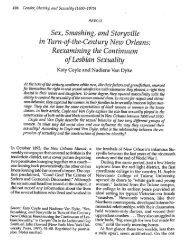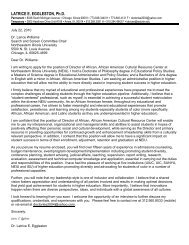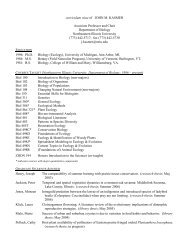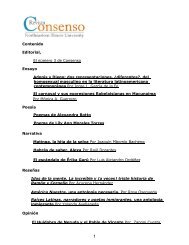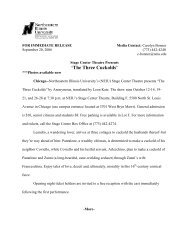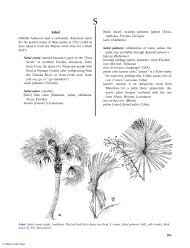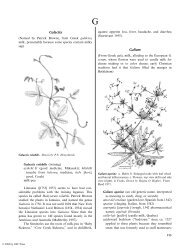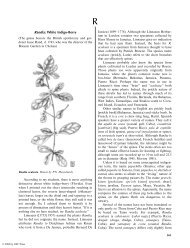Herba Cana - Northeastern Illinois University
Herba Cana - Northeastern Illinois University
Herba Cana - Northeastern Illinois University
You also want an ePaper? Increase the reach of your titles
YUMPU automatically turns print PDFs into web optimized ePapers that Google loves.
© 2004 by CRC Press<br />
The Ethnobotany 533<br />
sukee name sápiyâ:bî or sápiyî (resembling the mythical<br />
plant ‘‘sápiyi’’) (Sturtevant 1955). Snow and Stans<br />
(2001) used svpeyv as the Creek name.<br />
A more detailed explanation of svpeyv is given by<br />
Martin and Mauldin (2000). They wrote that this is<br />
the name of ‘‘a plant whose root is used as a charm,’’<br />
basing their comment on some notes made by Mary<br />
R. Haas ca. 1940. For the second meaning, they<br />
added, ‘‘a charm (once used for hunting, but now used<br />
to attract a suitor).’’<br />
Sturtevant (1955) wrote that the Creeks called<br />
Polygala, regardless of the species, hi:lamásî (hele,<br />
medicine, em, its, vse, tea, Creek). He was told<br />
that they used both P. lutea and P. rugelii, but<br />
that the former was better. His informants used<br />
Polygala for ‘‘Sapiyi Sickness’’ (heart palpitations,<br />
yellow skin, body swelling, shortness of breath),<br />
‘‘Chronic Sickness,’’ snakebite, birth medicine, and<br />
sorcery.<br />
Snow and Stans (2001) added the Creek names<br />
svpeyv hvlwat (svpeyv, polygala, hvlwv, high, -at, the<br />
one that is), and svpeyv lopockuce (svpeyv, polygala,<br />
lopocke, small, uce, small), plus the Mikasuki names<br />
wootaacheeke em oekekche (properly wootaacheeke em<br />
alekche, emetic medicine; from wootaach-, make<br />
vomit, -eeke, thing that, i.e., emetic, em, its, alekche,<br />
medicine), tofoome chayhe (chayhe, tall, Mikasuki; the<br />
first word may be cognate with Creek eto-home, bitter<br />
wood), and shapeye peshkooshka (small polygala).<br />
Bennett (1997) was told the Mikasuki name eeye<br />
mashe (eeye, foot, em, its, ashe, tea).<br />
In the ‘‘Plant Identification Chart for Creek<br />
Speakers,’’ Snow and Stans (2001) list P. grandiflora,<br />
P. lutea, and P. rugelii only under svpeyv and<br />
wootaacheeke em oekekche. There is apparently more<br />
about identification and use of the genus than<br />
the simple version given by Sturtevant (1955) indicates.<br />
Organisms that have uses older than cultural<br />
memory always have long and complex associations<br />
with people.<br />
Snow and Stans (2001) illustrate P. grandiflora in<br />
their Plate 24, and call it svpeyv, with the English<br />
names ‘‘small one’’ and ‘‘candy root.’’ Snow wrote,<br />
‘‘You find this plant in an open place on dry or damp<br />
land. Get four whole plants with the root attached.<br />
The thin stem is about a foot tall with small purple<br />
flowers, and the root is white. You use svpeyv for<br />
treatment to clean the body and to vomit. It is used in<br />
‘on the wagon medicine’ as well.’’ In keeping with<br />
Snow’s comment that svpeyv cleans the body, large<br />
doses of P. rugelii are reported to act as a strong<br />
laxative.<br />
The Choctaw used P. lutea (bog bachelor’s-button,<br />
candyweed, wild bachelor’s-button), calling it kwonokashaipsa<br />
[kwonokasha ipsa] (kowaanakaasha, little<br />
people, impa, eat it), as a poultice to treat swelling<br />
by infusing dried blossoms in hot water (Bushnell<br />
1909). Florida’s other species with a recorded use is<br />
P. polygama. As with several species, it has been used<br />
to treat coughs. Both probably contain the saponin<br />
wintergreen.<br />
John K. Small (1869 /1938), the botanist from<br />
New York Botanical Garden who explored Florida<br />
during his winter breaks, was the first to recognize one<br />
endemic species as distinct. He called that herb P.<br />
arenicola in 1905. In the 1970s, Robert R. Smith and<br />
Daniel B. Ward at the <strong>University</strong> of Florida realized<br />
that, because of a legal technicality, the plants needed<br />
a new name. They commemorated this New Yorker’s<br />
keen observations by dubbing the plants Polygala<br />
smallii.<br />
Urbanization in southern Florida has pushed P.<br />
smallii to the edge of extinction. The species was<br />
proposed for the Federal Endangered Plant List, and<br />
it became one of the first from the region to be listed<br />
in 1985. Because no one knew much about the plants,<br />
or why they were so restricted, several studies were<br />
initiated.<br />
Pamela Krauss, while at Florida Atlantic <strong>University</strong>,<br />
discovered by the early 1980s that the species was<br />
restricted to small sandy spots in rockland pine<br />
flatwoods in Miami-Dade County. Apparently, the<br />
Broward County plants were extirpated by then.<br />
About the same time John Popenoe, then Director of<br />
Fairchild Tropical Garden, found the species in<br />
Martin County’s Jonathan Dickinson State Park. In<br />
the late 1990s George Gann rediscovered the plants in<br />
Martin and subsequently in nearby Palm Beach and<br />
St. Lucie Counties.<br />
Even these northern populations reproduce erratically,<br />
and studies for the Florida Native Plant<br />
Society by Christine Lockhart are producing population<br />
data that will help future management of this<br />
highly endangered Florida endemic. One of the<br />
aspects of its biology that is a contributor to its spotty<br />
distribution is its isolation in ‘‘pockets’’ of sand within<br />
pinelands. Another of those aspects may be dispersal<br />
by ants.<br />
Ant colonies have limited ranges, and that restricts<br />
where the seeds can be carried. To accomplish their<br />
dispersal, Polygala seeds have special ‘‘food-bodies’’<br />
(elaisomes). Those tiny structures attract these small<br />
foraging insects. Ants carry the seeds back to their<br />
nests, eat the food, and then discard the seeds outside.<br />
The seeds, having been put in a rich garbage heap with<br />
plenty of open space and reduced competition, germinate<br />
and provide new colonies. Perhaps our disruption<br />
of native ants with pesticides and alien introduced ants<br />
is showing us the ‘‘ripple-effect’’ of disturbing one<br />
small segment of the web of life.





